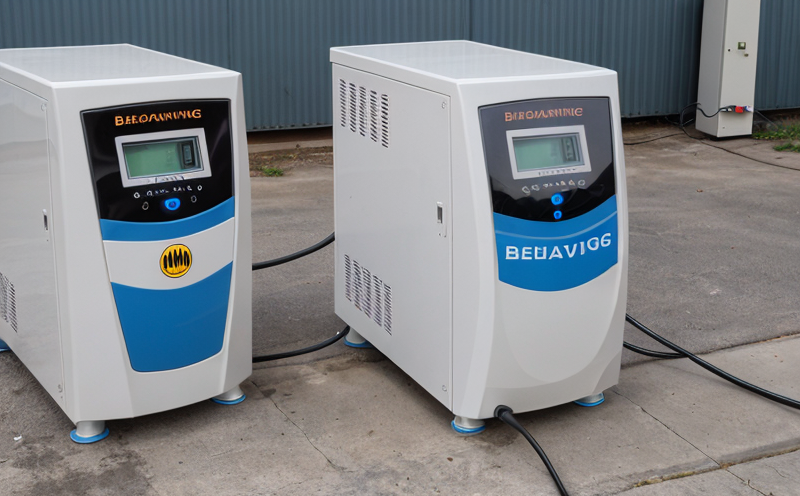ASTM E2395 Charging and Discharging Behavior Testing of Lithium Batteries under Extreme Conditions
The ASTM E2395 standard is a critical tool in the quality assurance process for lithium battery manufacturers, ensuring that batteries meet stringent performance criteria even when subjected to extreme environmental conditions. This service focuses on the testing methodologies outlined in ASTM E2395, which evaluates how lithium batteries perform under both high and low temperatures during charging and discharging processes.
Lithium batteries are essential components across various sectors including automotive, electronics, and consumer products. Their reliability is crucial for safety and performance, especially when subjected to extreme environmental conditions. ASTM E2395 provides a standardized approach to assessing the behavior of lithium batteries under these challenging circumstances, ensuring consistency and repeatability in testing.
The test procedure specified in ASTM E2395 involves charging and discharging lithium-ion cells or batteries at controlled temperatures ranging from -40°C to 60°C. The aim is to simulate real-world conditions that the battery might encounter during use. This includes not only ensuring the battery functions correctly but also assessing its durability and lifespan under these extreme temperature fluctuations.
Before testing, careful preparation of the specimens is essential. Lithium batteries must be conditioned according to specific guidelines provided in ASTM E2395 to ensure accurate results. The conditioning process involves charging and discharging the battery at specified rates until it reaches a stable state. This step ensures that any initial variations due to manufacturing inconsistencies are minimized, providing more reliable test data.
The instrumentation used for this testing includes advanced temperature-controlled chambers capable of maintaining precise control over internal temperatures. These chambers allow for accurate simulation of both hot and cold environments, ensuring the battery is tested under conditions as close to real-world scenarios as possible. Other key equipment includes programmable power supplies that can deliver controlled charging and discharging currents.
Once the batteries have been conditioned, they undergo a series of charge-discharge cycles at varying temperatures. The test protocol specifies exact current limits, voltage thresholds, and time intervals for each cycle to ensure consistent results. This process allows engineers to observe how well the battery maintains its capacity throughout multiple charging and discharging events.
The data collected during these tests is then analyzed using statistical methods to determine whether the battery meets all specified criteria outlined in ASTM E2395. Compliance with this standard indicates that the battery has passed rigorous testing for performance under extreme temperatures, making it suitable for use in demanding applications.
This service not only provides peace of mind regarding product quality but also helps companies comply with regulatory requirements set by industry bodies and governments worldwide. By adhering to ASTM E2395 standards, manufacturers can demonstrate their commitment to producing reliable and safe lithium batteries that meet international expectations.
- Extreme temperature simulation
- Conditioning of specimens according to ASTM E2395 guidelines
- Use of advanced temperature-controlled chambers
- Programmable power supplies for accurate current delivery
- Data analysis using statistical methods
Applied Standards
The primary standard used for this service is ASTM E2395, which specifies the testing procedures for evaluating the charging and discharging behavior of lithium batteries under extreme conditions. This includes both high and low temperatures, ensuring that the battery can perform reliably across a wide range of environmental factors.
ASTM E2395 sets out clear guidelines on how to condition the samples before testing, as well as the exact procedures for charging and discharging the batteries at specified temperature ranges. The standard also provides criteria for acceptable performance metrics, such as maximum allowable voltage drops during charge-discharge cycles.
In addition to ASTM E2395, other relevant standards may include ISO 12405-1 which deals with general requirements for secondary cells and batteries containing lithium, and IEC 62682 which covers safety aspects of portable rechargeable energy storage systems (RESS). These additional standards complement the work done under ASTM E2395 by providing broader perspectives on battery safety and performance.
Scope and Methodology
The scope of ASTM E2395 Charging and Discharging Behavior Testing encompasses a comprehensive evaluation of lithium batteries' charging and discharging characteristics when subjected to extreme temperature conditions. The primary focus is on ensuring that the battery maintains its operational integrity, capacity retention, and safety throughout these challenging environments.
The methodology involves conditioning the battery according to ASTM E2395 guidelines before conducting charge-discharge cycles at predetermined temperatures. Each cycle includes specific parameters such as current limit, voltage threshold, and duration, all designed to simulate real-world usage scenarios accurately.
During each test run, critical data points are recorded including open-circuit voltage (OCV), internal resistance, and total capacity. These metrics help assess the battery's health and performance under stress conditions. Post-test analysis involves comparing these values against baseline measurements taken during initial conditioning to identify any significant changes or failures.
The results of this testing serve multiple purposes. For manufacturers, it provides valuable insights into potential improvements needed for better temperature resilience in future designs. For quality managers and compliance officers, passing ASTM E2395 ensures adherence to international standards, enhancing brand reputation and market acceptance. R&D engineers benefit from detailed test data that can guide further developments towards more robust battery technologies.
International Acceptance and Recognition
The ASTM E2395 standard enjoys widespread acceptance across various industries worldwide, including automotive manufacturers, electronics firms, and consumer goods producers. Its rigorous testing protocols have earned it significant recognition from regulatory bodies like the European Union's New Regulatory Framework (NRF) for batteries.
- Australia - Recognized by Australian Standards
- China - Included in Chinese National Standards
- Japan - Adopted into Japan Industrial Standards
- United States - Formally incorporated into U.S. Federal Specifications
- Canada - Part of Canadian Technical Standards and Regulations
Besides governmental bodies, numerous private entities also consider adherence to ASTM E2395 as a benchmark for quality assurance in their supply chains. This broad acceptance underscores the importance of this standard in ensuring consistent battery performance standards globally.





